
TL/DR
We have discussed how AI and Web3 can each take advantage of each other and complement each other in various vertical industries such as computing networks, proxy platforms and consumer applications.When focusing on the vertical field of data resources, emerging web projects provide new possibilities for data acquisition, sharing and utilization.
-
Traditional data providers have difficulty meeting the needs of AI and other data-driven industries for high-quality, real-time verifiable data, especially in terms of transparency, user control and privacy protection
-
Web3 solutions are working to reshape the data ecosystem.Technologies such as MPC, zero-knowledge proof and TLS Notary ensure authenticity and privacy protection when data circulates between multiple sources, while distributed storage and edge computing provide greater flexibility and efficiency for real-time processing of data.
-
inDecentralized data networkThis emerging infrastructure has spawned several representative projects, OpenLayer (modular real data layer), Grass (using user idle bandwidth and decentralized crawler node networks) and Vana (user data sovereignty Layer 1 networks), with differentThe technical path opens up new prospects for AI training and application fields.
-
Through crowdsourcing capacity, trustless abstraction layer and token-based incentive mechanisms, decentralized data infrastructure can provide more private, secure, efficient and economical solutions than Web2 hyperscale service providers, and give users the ability to use it.Control of data and its related resources, building a more open, secure and interconnected digital ecosystem.
1.The wave of data demand
Data has become a key driver of innovation and decision-making in various industries.UBS predicts that the global data volume is expected to grow by more than tenfold to 660 ZB between 2020 and 2030, and by 2025, each person in the world will generate 463 EB (Exabytes, 1EB=1 billion GB) of data per person per day.The data-as-a-service (DaaS) market is expanding rapidly, and according to a report by Grand View Research, the global DaaS market is valued at US$14.36 billion in 2023 and is expected to grow at a CAGR of 28.1% by 2030, eventually reaching 768.$100 million.Behind these high-growth numbers is the demand for high-quality, real-time trusted data in multiple industrial fields.
AI model training relies on a large amount of data input to identify patterns and adjust parameters.After training, the data set is also required to test the performance and generalization capabilities of the model.In addition, AI agents, as a foreseeable emerging intelligent application form in the future, require real-time and reliable data sources to ensure accurate decision-making and task execution.
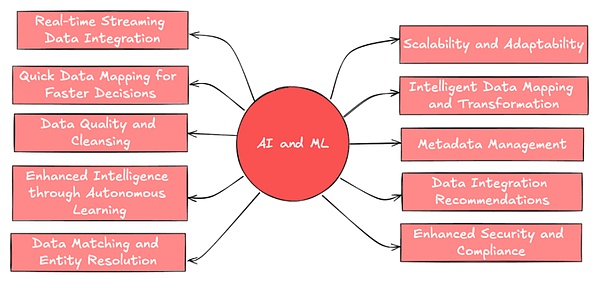
(Source: Leewayhertz)
The demand for business analysis is also becoming diverse and extensive, and has become the core tool to drive corporate innovation.For example, social media platforms and market research companies need reliable user behavior data to formulate strategies and insight into trends, integrate multiple data from multiple social platforms, and build a more comprehensive portrait.
For the Web3 ecosystem, reliable and real data is also needed on-chain to support some new financial products.As more and more new assets are being tokenized, flexible and reliable data interfaces are needed to support the development and risk management of innovative products, allowing smart contracts to be executed based on verifiable real-time data.
In addition to the above, there are scientific research, the Internet of Things (IoT), etc.New use cases The demand for diverse, real-time data in various industries is rising, while traditional systems may struggle to cope with rapidly growing data volumes and changing demands.
2. Limitations and Problems of Traditional Data Ecology
A typical data ecosystem includes data collection, storage, processing, analysis, and application.The centralized model is characterized by centralized data collection and storage, management and operation and maintenance by the core enterprise IT team, and strict access control is implemented.
For example, Google’s data ecosystem covers multiple data sources, from search engines, Gmail to Android operating systems, and uses these platforms to collect user data, store it in its globally distributed data center, and then use algorithms to process and analyze to support variousDevelopment and optimization of products and services.
For example in the financial market, the Data and Infrastructure LSEG (formerly Refinitiv) uses real-time and historical data to obtain global exchanges, banks and other major financial institutions, and uses its own Reuters News network to collect market-related news and use its proprietaryAlgorithms and models generate analytical data and risk assessment as additional products.
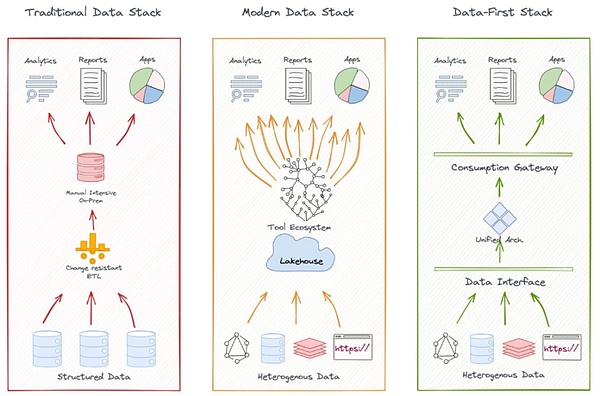
(Source: kdnuggets.com)
Traditional data architectures are effective in professional services, but the limitations of centralized models are becoming increasingly obvious.In particular, traditional data ecosystems are facing challenges in terms of coverage, transparency and user privacy protection of emerging data sources.Here are a few examples:
-
Inadequate data coverage: Traditional data providers have challenges in quickly capturing and analyzing emerging data sources such as social media sentiment, IoT device data.Centralized systems are difficult to efficiently acquire and integrate “long tail” data from numerous small-scale or non-mainstream sources.
For example, the GameStop incident in 2021 reveals the limitations of traditional financial data providers when analyzing social media sentiment.Investor sentiment on platforms such as Reddit has quickly changed the market trend, but data terminals like Bloomberg and Reuters failed to capture these dynamics in a timely manner, resulting in a lag in market forecasts.
-
Data accessibility is limited: Monopoly limits accessibility.Many traditional providers open up some of their data through API/cloud services, but the high access costs and complex authorization processes still increase the difficulty of data integration.
It is difficult for on-chain developers to quickly access reliable off-chain data, and high-quality data is monopolized by a few giants, and the access cost is high.
-
Data transparency and credibility issues: Many centralized data providers lack transparency in their data collection and processing methods, and lack effective mechanisms to verify the authenticity and integrity of large-scale data.The verification of large-scale real-time data remains a complex issue, and the nature of centralization also increases the risk of data being tampered with or manipulated.
-
Privacy protection and data ownership: Large technology companies have used user data on a large scale.As creators of private data, it is difficult for users to get the rewards they deserve.Users often have no idea how their data is collected, processed and used, and it is also difficult to determine the scope and way of using the data.Overcollecting and using it also leads to serious privacy risks.
For example, Facebook’s Cambridge Analytica incident exposed huge vulnerabilities in how traditional data providers can use transparency and privacy.
-
Data island: In addition, real-time data from different sources and formats is difficult to quickly integrate, which affects the possibility of comprehensive analysis.A lot of data is often locked inside an organization, limiting data sharing and innovation across industries and across organizations, and the data silo effect hinders cross-domain data integration and analysis.
For example, in the consumer industry, brands need to integrate data from e-commerce platforms, physical stores, social media and market research, but these data may be difficult to integrate due to inconsistent or quarantine of the platform format.For example, shared travel companies like Uber and Lyft, although they both collect a large amount of real-time data about transportation, passenger needs and geographical location from users, cannot be proposed and shared and integrated due to competition.
In addition, there are also issues such as cost efficiency and flexibility.Traditional data providers are actively responding to these challenges, but the emerging Web3 technology provides new ideas and possibilities for solving these problems.
3.Web3 data ecosystem
Since the release of decentralized storage solutions such as IPFS (InterPlanetary File System) in 2014, a series of emerging projects have emerged in the industry, committed to solving the limitations of the traditional data ecosystem.We see that decentralized data solutions have formed a multi-level, interconnected ecosystem covering all stages of the data life cycle, including data generation, storage, exchange, processing and analysis, verification and security, and privacy andownership.
-
Data storage: The rapid development of Filecoin and Arweave proves that decentralized storage (DCS) is becoming a paradigm shift in the storage space.The DCS scheme reduces the risk of single point failure through a distributed architecture while attracting participants with a more competitive cost-effectiveness.With the emergence of a series of large-scale application cases, DCS storage capacity has shown explosive growth (for example, the total storage capacity of Filecoin network has reached 22 exabytes in 2024).
-
Processing and analysis: Decentralized data computing platforms such as Fluence improve the real-time and efficiency of data processing through edge computing technology, and are especially suitable for application scenarios such as the Internet of Things (IoT) and AI inference that require high real-time performance.The Web3 project uses technologies such as federated learning, differential privacy, trusted execution environment, and fully homomorphic encryption to provide flexible privacy protection and trade-offs on the computing layer.
-
Data Market/Exchange Platform: In order to promote the quantification and circulation of data value, Ocean Protocol has created efficient and open data exchange channels through tokenization and DEX mechanisms, such as helping traditional manufacturing companies (Mercedes-Benz parent company Daimler) cooperate to develop the data exchange market to help themData sharing in supply chain management.Streamr, on the other hand, has created a permissionless, subscription-based data streaming network suitable for IoT and real-time analytics scenarios, showing outstanding potential in transportation and logistics projects (such as working with Finnish smart city projects).
With the increasing frequency of data exchange and utilization, the authenticity, credibility and privacy of data have become key issues that cannot be ignored.This has prompted the Web3 ecosystem to extend innovation to the areas of data verification and privacy protection, giving birth to a series of breakthrough solutions.
3.1 Innovation in data verification and privacy protection
Many web3 technology and native projects are working to solve data authenticity and private data protection issues.In addition to ZK, MPC and other technologies have been widely used, among which Transport Layer Security Protocol Notary (TLS Notary) is particularly worthy of attention as an emerging verification method.
Introduction to TLS Notary
Transport Layer Security Protocol (TLS) is an encryption protocol widely used in network communications, aiming to ensure the security, integrity and confidentiality of data transmission between clients and servers.It is a common encryption standard in modern network communication and is used in HTTPS, email, instant messaging and other scenarios.

(TLS encryption principle, Source: TechTarget)
When it was born ten years ago, TLS Notary’s initial goal was to verify the authenticity of TLS sessions by introducing third-party “notaries” outside the client (Prover) and server.
Using key segmentation technology, the master key of the TLS session is divided into two parts, held by the client and the notary.This design allows notaries to participate in the verification process as trusted third parties, but cannot access the actual communication content.This notarization mechanism is designed to detect man-in-the-middle attacks, prevent fraudulent certificates, ensure that communication data is not tampered with during transmission, and allow trusted third parties to confirm the legitimacy of communications while protecting communication privacy.
Therefore, TLS Notary provides secure data verification and effectively balances verification requirements and privacy protection.
In 2022, the TLS Notary project is rebuilt by the Ethereum Foundation’s Privacy and Extension Exploration (PSE) Research Lab.The new version of the TLS Notary protocol is rewritten from scratch in Rust language, incorporates more advanced encryption protocols (such as MPC). The new protocol feature allows users to prove to third parties the authenticity of the data they receive from the server, while notLeaked data content.While maintaining the original TLS Notary core verification function, it greatly improves privacy protection capabilities, making it more suitable for current and future data privacy needs.
3.2 Variations and extensions of TLS Notary
In recent years, TLS Notary technology has also been continuously evolving, and has developed on the basis of the development and produced multiple variants, further enhancing privacy and verification functions:
-
zkTLS: A privacy-enhanced version of TLS Notary, combined with ZKP technology, allows users to generate encrypted proofs of web page data without exposing any sensitive information.It is suitable for communication scenarios that require extremely high privacy protection.
-
3P-TLS (Three-Party TLS): The client, server and auditor are introduced to allow auditors to verify the security of communication without leaking the communication content.This protocol is very useful in scenarios where transparency is required but privacy protection is required, such as compliance reviews or audits of financial transactions.
Web3 projects use these encryption technologies to enhance data verification and privacy protection, break data monopoly, solve data silos and trustworthy transmission problems, and allow users to prove their privacy without revealing their shopping records for social media accounts and financial loans., bank credit history, professional background and academic certification information, such as:
-
Reclaim Protocol uses zkTLS technology to generate zero-knowledge proofs of HTTPS traffic, allowing users to securely import activity, reputation and identity data from external websites without exposing sensitive information.
-
zkPass combines 3P-TLS technology to allow users to verify real-world private data without leakage. It is widely used in KYC, credit services and other scenarios, and is compatible with HTTPS networks.
-
Opacity Network is based on zkTLS, allowing users to safely prove their activity on various platforms (such as Uber, Spotify, Netflix, etc.) without directly accessing the APIs of those platforms.Implement cross-platform activity proof.
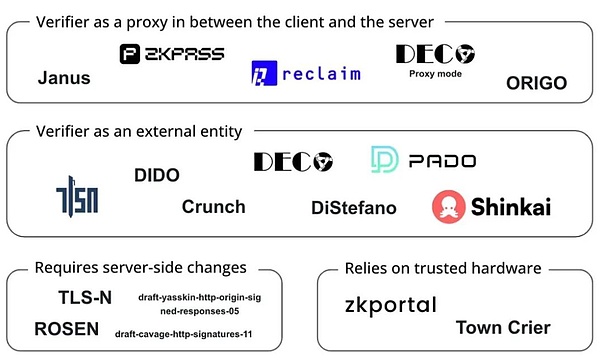
(Projects working on TLS Oracles, Source: Bastian Wetzel)
As an important link in the data ecosystem chain, Web3 data verification has broad application prospects. The prosperity of its ecosystem is guiding a more open, dynamic and user-centered digital economy.However, the development of authenticity verification technology is only the beginning of building a new generation of data infrastructure.
4. Decentralized data network
Some projects combine the above-mentioned data verification technology to make more in-depth explorations in the upstream of the data ecosystem, namely data traceability, distributed data collection and trusted transmission.Here are several representative projects: OpenLayer, Grass and Vana, which show unique potential in building a next-generation data infrastructure.
4.1 OpenLayer
OpenLayer is one of the a16z Crypto Spring 2024 Crypto Entrepreneurship Accelerator Projects, serving as the first modular real data layer, committed to providing an innovative modular solution for coordinating data collection, verification and transformation to meet both Web2 andWeb3 companies need.OpenLayer has attracted support from well-known funds and angel investors including Geometry Ventures, LongHash Ventures.
There are multiple challenges in the traditional data layer: the lack of trusted verification mechanism, the dependence on centralized architecture leads to limitation of access, the data between different systems lacks interoperability and liquidity, and there is also no fair data value allocation mechanism.
A more concrete problem is that AI training data is becoming increasingly scarce today.On the public Internet, many websites have begun to use anti-crawler restrictions to prevent AI companies from crawling data at scale.
And inPrivate and proprietary dataOn the one hand, the situation is more complicated. Many valuable data are stored in a privacy-protected manner due to their sensitive nature, and lacks effective incentive mechanisms.Under this status quo, users cannot securely obtain direct benefits by providing private data and are therefore unwilling to share this sensitive data.
To solve these problems, OpenLayer has built a modular Authentic Data Layer with data verification technology, and coordinated the data collection, verification and conversion process in a decentralized + economic incentives, for Web2 and Web3 companies.Provide a safer, more efficient and flexible data infrastructure.
4.1.1 The core components of OpenLayer modular design
OpenLayer provides a modular platform to simplify the process of data collection, trusted verification and conversion:
a) OpenNodes
OpenNodes is the core component responsible for decentralized data collection in the OpenLayer ecosystem. Data is collected through users’ mobile applications, browser extensions and other channels. Different operators/nodes can perform the most suitable tasks according to their hardware specifications and optimize returns.
OpenNodes supports three main data types to meet the needs of different types of tasks:
-
Publicly available Internet data (such as financial data, weather data, sports data and social media streams)
-
User private data (such as Netflix viewing history, Amazon order history, etc.)
-
Self-reported data from secure sources (such as data signed by a proprietary owner or verified by a specific trusted hardware).
Developers can easily add new data types, specify new data sources, requirements and data retrieval methods, and users can choose to provide de-identified data in exchange for rewards.This design allows the system to continuously expand to adapt to new data needs. The diversified data sources allow OpenLayer to provide comprehensive data support for various application scenarios, and also lowers the threshold for data provision.
b) OpenValidators
OpenValidators are responsible for the data verification after collection, allowing data consumers to confirm that the data provided by the user is exactly matched with the data source.All provided verification methods can be verified by encryption, and the verification results can be verified afterwards.For the same type of proof, there are multiple different providers to provide services.Developers can choose the most suitable verification provider according to their needs.
In initial use cases, especially for public or private data from the Internet API, OpenLayer uses TLSNotary as a verification solution to export data from any web application and prove the authenticity of the data without compromising privacy.
Not limited to TLSNotary, thanks to its modular design, the verification system can easily access other verification methods to suit different types of data and verification needs including but not limited to:
-
Attested TLS connections: Use a Trusted Execution Environment (TEE) to establish a certified TLS connection to ensure the integrity and authenticity of data during transmission.
-
Secure Enclaves: Use hardware-level secure isolation environments (such as Intel SGX) to process and verify sensitive data to provide a higher level of data protection.
-
ZK Proof Generators: Integrated ZKP, allowing verification of data properties or calculation results without revealing original data.
c) OpenConnect
OpenConnect is the core module in the OpenLayer ecosystem responsible for data conversion and realizing availability, processing data from various sources, ensuring the interoperability of data between different systems, and meeting the needs of different applications.For example:
-
Convert data to an on-chain oracle format, which is convenient for the direct use of smart contracts.
-
Convert unstructured raw data into structured data and perform pre-processing for AI training and other purposes.
For data from users’ private accounts, OpenConnect provides data desensitization to protect privacy, and also provides components to enhance security during data sharing and reduce data breaches and abuse.In order to meet the needs of real-time data for applications such as AI and blockchain, OpenConnect supports efficient real-time data conversion.
At present, through integration with Eigenlayer, OpenLayer AVS operator monitors data request tasks, is responsible for crawling data and verifying it, and then reports the results back to the system to pledge or re-stake assets through EigenLayer to provide financial guarantees for its behavior.If malicious behavior is confirmed, you will face the risk of being fined and confiscated from the pledged assets.As one of the earliest AVS (active verification services) on the EigenLayer main network, OpenLayer has attracted more than 50 operators and $4 billion in re-staking assets.
In general, the decentralized data layer built by OpenLayer expands the scope and diversity of available data without sacrificing practicality and efficiency, while ensuring the authenticity of the data through encryption technology and economic incentives.Integrity.Its technology has a wide range of practical use cases for Web3 Dapps seeking to obtain off-chain information, AI models that require real input to train and infer, and companies that want to segment and locate users based on existing identities and reputations.Users are also able to value their private data.
4.2 Grass
Grass is a flagship project developed by Wynd Network to create a decentralized web crawler and AI training data platform.At the end of 2023, the Grass project completed a $3.5 million seed round led by Polychain Capital and Tribe Capital.Immediately afterwards, in September 2024, the project ushered in a Series A financing led by HackVC, with well-known investment institutions such as Polychain, Delphi, Lattice and Brevan Howard also participated.
We mentioned that AI training requires new data exposure, and one of the solutions is to use multiple IPs to break through data access permissions and feed AI data.Grass started from this to create a distributed crawler node network, dedicated to using users’ idle bandwidth to collect and provide verifiable data sets for AI training in the form of decentralized physical infrastructure.The node routes web requests through the user’s Internet connection, accesses public websites and compiles structured data sets.It uses edge computing technology to perform preliminary data cleaning and formatting to improve data quality.
Grass adopts the Solana Layer 2 Data Rollup architecture, built on Solana to improve processing efficiency.Grass uses a validator to receive, verify and batch web transactions from nodes, generating ZK proofs to ensure data authenticity.The verified data is stored in the data ledger (L2) and linked to the corresponding L1 chain proof.
4.2.1 Grass main components
a) Grass node
Similar to OpenNodes, C-end users install Grass applications or browser extensions and run them, use idle bandwidth to perform network crawling operations, nodes route web requests through the user’s Internet connection, access public websites and compile structured data sets, and use edge computing technology to perform.Preliminary data cleaning and formatting.Users receive GRASS token rewards based on the bandwidth and amount of data contributed.
b) Routers
Connect Grass nodes and validators, manage node networks and relay bandwidth.Routers are incentivized to operate and receive rewards, with the reward ratio proportion proportion proportion proportions to the total verification bandwidth passed through it.
c) Validators
Receive, verify and batch web transactions from the router, generate ZK proofs, use a unique key set to establish a TLS connection, and select the appropriate cipher suite for communication with the target web server.Grass currently uses a centralized validator and plans to move to the validator committee in the future.
d) ZK Processor (ZK Processor)
Receive proof of generating each node session data from the verifier, batch proof of validity of all web requests and submit to Layer 1 (Solana).
e) Grass Data Ledger (Grass L2)
Store the complete data set and link it to the corresponding L1 chain (Solana).
f) Edge embedding model
Responsible for converting unstructured web data into structured models that can be trained with AI.
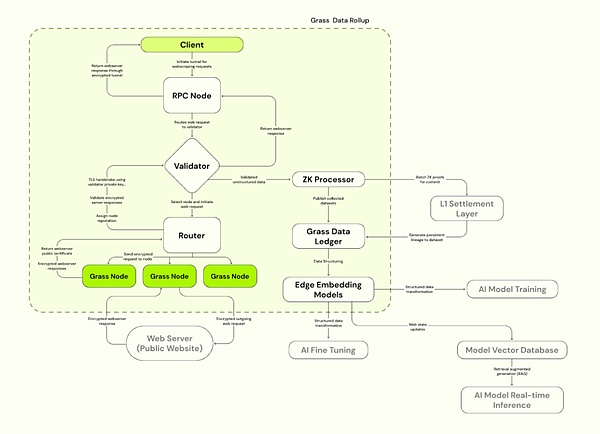
Source: Grass
Analysis and comparison of Grass and OpenLayer
Both OpenLayer and Grass leverage distributed networks to provide companies with the opportunity to access open internet data and closed information that requires authentication.The incentive mechanism promotes data sharing and high-quality data production.Both are committed to creating a decentralized data layer to solve the problem of data acquisition access and verification, but adopt slightly different technical paths and business models.
Different technical architectures
Grass uses the Layer 2 Data Rollup architecture on Solana, and currently uses a centralized verification mechanism and a single validator.As the first batch of AVS, Openlayer is built on EigenLayer and uses economic incentives and confiscation mechanisms to achieveDecentralized verification mechanism.It also adopts a modular design, emphasizing the scalability and flexibility of data verification services.
Product Differences
Both offer similar To C products, allowing users to monetize the value of data through nodes.On To B use cases, Grass provides an interesting data market model and uses L2 to verbally store complete data to provide AI companies with a structured, high-quality, verifiable training set.OpenLayer does not have a temporary dedicated data storage component, but provides a wider range of real-time data flow verification services (Vaas). In addition to providing data for AI, it is also suitable for scenarios that require rapid response, such as Oracle for the RWA/DeFi/prediction marketProject price feed, provide real-time social data, and more.
Therefore, Grass’ target customer base is mainly aimed at AI companies and data scientists, providing large-scale and structured training data sets, and also serving research institutions and enterprises that require a large number of network data sets; while Openlayer is temporarily aimed at off-chain data needs.Sources on-chain developers, AI companies that require real-time, verifiable data streams, and innovative user acquisition strategies such as Web2 companies that verify competitor usage history.
Potential competition in the future
However, considering the industry trends, the functions of the two projects are indeed likely to converge in the future.Grass may also provide real-time structured data soon.As a modular platform, OpenLayer may also expand to data set management in the future to have its own data ledger, so the competitive areas of the two may gradually overlap.
In addition, both projects may consider adding data labeling as a key link.Grass may move faster in this regard, as they have a huge network of nodes – reportedly more than 2.2 million active nodes.This advantage gives Grass the potential to provide reinforcement learning (RLHF) services based on human feedback, using a large amount of labeled data to optimize AI models.
However, OpenLayer, with its expertise in data verification and real-time processing, may maintain its advantages in data quality and credibility.In addition, as one of Eigenlayer’s AVS, OpenLayer may have further development in the decentralized verification mechanism.
尽管两个项目可能在某些领域展开竞争, 但它们各自的独特优势和技术路线也可能导致它们在数据生态系统中占据不同的利基市场。

(Source: IOSG, David)
4.3 VAVA
作为一个以用户为中心的数据池网络,Vana同样致力于为AI和相关应用提供高质量数据。Compared with OpenLayer and Grass, Vana adopts more different technology paths and business models.Vana completed a $5 million financing in September 2024, led by Coinbase Ventures. It was previously awarded a $18 million Series A financing led by Paradigm. Other well-known investors include Polychain, Casey Caruso, etc.
Originally launched in 2018 as a research project for MIT, Vana aims to become a Layer 1 blockchain designed specifically for user private data.Its innovations in data ownership and value allocation enable users to profit from AI models trained on their data.The core of Vana is through trustless, private, and attributableData Liquidity Pooland innovativeProof of Contribution机制来实现私人数据的流通和价值化:
4.3.1. 数据流动性池(Data Liquidity Pool)
Vana 引入了一个独特的数据流动性池(DLP)概念:作为Vana网络的核心组件,每个DLP都是一个独立的点对点网络,用于聚合特定类型的数据资产。Users can upload their private data (such as shopping history, browsing habits, social media activities, etc.) to a specific DLP and flexibly choose whether to authorize this data to specific third parties for use.Data is integrated and managed through these liquidity pools, which are de-identified to ensure user privacy while allowing data to participate in commercial applications, such as for AI model training or market research.
Users submit data to DLP and receive corresponding DLP tokens (each DLP has a specific token) reward. These tokens not only represent the user’s contribution to the data pool, but also give users the right to govern DLP and the right to distribute future profits..Not only can users share data, but they can also obtain continuous benefits from subsequent calls to the data (and provide visual tracking).Unlike traditional single-time data sales, Vana allows data to continue to participate in the economic cycle.
4.3.2. Proof of Contribution Mechanism
One of Vana’s other core innovations isProof of Contribution(Proof of Contribution) mechanism.This is Vana’s key mechanism to ensure data quality, allowing each DLP to customize unique contribution proof functions based on its characteristics to verify the authenticity and integrity of the data and evaluate the data’s contribution to the performance improvement of AI model.This mechanism ensures that users’ data contributions are quantified and recorded, thus providing rewards to users.Similar to the “Proof of Work” in cryptocurrencies, Proof of Contribution distributes benefits to users based on the quality, quantity of data contributed by users and the frequency of use.Automatic execution of smart contracts ensures that contributors receive rewards that match their contributions.
Vana’s technical architecture
-
Data Liquidity Layer
This is Vana’s core layer, responsible for the contribution, verification and recording of data to DLPs, and introduce data to the chain as a transferable digital asset.DLP creators deploy DLP smart contracts to set the purpose of data contribution, verification methods and contribution parameters.Data contributors and custodians submit data for verification, and the Proof of Contribution (PoC) module performs data verification and value assessment, and grants governance rights and rewards based on parameters.
-
Data Portability Layer
This is an open data platform for data contributors and developers, and it is also the application layer of Vana.Data Portability Layer provides a collaboration space for data contributors and developers to build applications using the data liquidity accumulated in DLPs.Provides infrastructure for distributed training of User-Owned models and AI Dapp development.
-
Universal Connectome
A decentralized ledger is also a real-time data flow chart that runs through the entire Vana ecosystem. It uses the Proof of Stake to record real-time data transactions in the Vana ecosystem.Ensure effective transfer of DLP tokens and provide cross-DLP data access to applications.Compatible with EVM, allowing interoperability with other networks, protocols and DeFi applications.
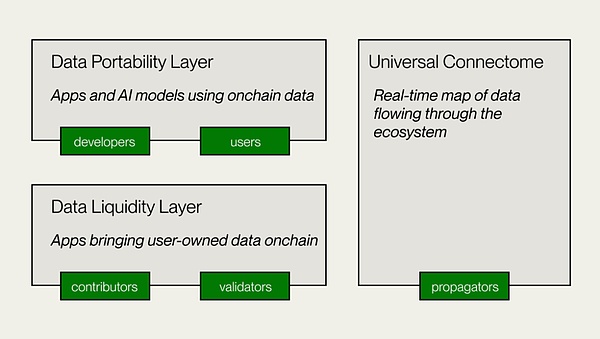
(Source: Vana)
Vana provides a relatively different path, focusing on the liquidity and value empowerment of user data. This decentralized data exchange model is not only suitable for AI training, data market and other scenarios, but also for user data in the Web3 ecosystem.Cross-platform interoperability and licensing provide a new solution.Ultimately create an open Internet ecosystem that allows users to own and manage their own data, as well as smart products created from this data.
5. The value proposition of decentralized data networks
Data scientist Clive Humby said in 2006 that data is oil in the new era.In the past 20 years, we have witnessed the rapid development of “refining” technology.Technology such as big data analysis and machine learning have enabled unprecedented data value.According to IDC’s forecast, by 2025, the global data circle will grow to 163 ZB, most of which will come from individual users. With the popularization of emerging technologies such as IoT, wearable devices, AI and personalized services, a large number of them will need to be commercialized in the future.The data will also be derived from individuals.
Pain points of traditional solutions: Unlocking innovation in Web3
Through a distributed node network, the Web3 data solution breaks through the limitations of traditional facilities, achieves wider and more efficient data acquisition, and improves the real-time acquisition efficiency and verification credibility of specific data.In this process, Web3 technology ensures the authenticity and integrity of data and can effectively protect user privacy, thereby achieving a fairer data utilization model.This decentralized data architecture promotes data acquisitionDemocratization.
Whether it is the user node mode of OpenLayer and Grass, or Vana’s monetization of user private data, in addition to improving the efficiency of specific data collection, ordinary users can share the dividends of data economy, creating a win-win model for users and developers, so thatUsers truly control and benefit from their data and related resources.
Through the token economy, the Web3 data solution has redesigned the incentive model and created a more fair data value allocation mechanism.It has attracted a large number of users, hardware resources and capital to coordinate and optimize the operation of the entire data network.
They also haveModularity and scalability: For example, Openlayer’s modular design provides flexibility for future technological iteration and ecological expansion.Thanks to technical characteristics, we optimize the data acquisition method of AI model training to provide richer and more diverse data sets.
From data generation, storage, verification to exchange and analysis, Web3-driven solutions solve many disadvantages of traditional facilities through unique technological advantages, and also give users the ability to monetize personal data, triggering a fundamental change in the data economic model.With the further development and evolution of technology and the expansion of application scenarios, the decentralized data layer is expected to become the next generation of critical infrastructure, together with other Web3 data solutions, and provide support for a wide range of data-driven industries.








